Assessing and Mapping Forest Functions through a GIS-Based, Multi-Criteria Approach as a Participative Planning Tool: An Application Analysis
Abstract
1. Introduction
- Productive function (PRD) includes all the activities that remove wood from the forests for use as timber or fuelwood, as well as other possible forest resources (such as cork). Non-wood products should also be included in the possible range of forest products (such as mushrooms, small fruits and berries, herbs, hunting, free-range grazing animals and their products, etc.). According to the CICES classification system, these functions are grouped under the provisioning service.
- Protective function (PRT) comprises the defense of soil from wind and water erosion, as well as the reduction in landslides, water run-off, and flood risks, together with other environmental benefits provided by tree land cover. Protection against soil hydrogeological instability can be assigned to a regulation and maintenance service according to the CICES classification system.
- Naturalistic function (NTR) involves biodiversity safeguards and landscape conservation. Indeed, forests serve as important habitats for a wide variety of species (both flora and fauna). By hosting so many species, forests support a rich biodiversity that needs to be protected. This function is now seen as a strategic benefit that meets an important societal demand. The CICES classification system places this type of service under the category of regulation of the biotic environment, which also includes protection of habitats and gene pools (ecosystem, species and genes are recognized as the three hierarchical levels of biodiversity). “Carbon sink and sequestration” can also be included in this type of function, as afforestation and reforestation are recognized as important climate change mitigation measures.
- Tourist function (TRS) refers to the cultural and recreational use of forests. Forests can provide a host of outdoor recreational activities for young and elderly people, encouraging an active and healthy lifestyle and improving the well-being of the body and mind. A wide range of physical, mental and health activities can be carried out in the forest, including traditional activities such as hiking and trekking. As suggested by both the Millennium Ecosystem Assessment [26,27] and the CICES classification system, the tourist or recreational function can be included in the broader category of cultural services, defined as “nonmaterial benefits that people derive from ecosystems through spiritual enrichment, cognitive development, reflection, recreation and aesthetic experiences”.
2. Materials and Methods
2.1. The Study Area
2.2. Methodological Approach
2.3. AHP Application
2.4. Forest Zoning through GIS Mapping
2.5. Remarks on GIS-AHP Integration
3. Results
3.1. Spatial Distribution of Forest Cover and Main Forest Features in the Area
3.2. AHP Results
3.3. Assignment of the Dominant Forest Functions to Forest Units
3.4. Mapping and Zoning of the Forest Functions
4. Discussion
4.1. The Local Forest Plan: A Mesoscale Planning Tool
4.2. Forest Planning as an Interface between Nature and Man
4.3. Forest Ecosystem Services as Commons
4.4. The Multifunctional Role of Forests
4.5. Forest Functions, Forest Professional Activities and New Potential Forest Jobs
5. Conclusions
Author Contributions
Funding
Data Availability Statement
Conflicts of Interest
Abbreviations
References
- Miura, S.; Amacher, M.; Hofer, T.; San-Miguel-Ayanz, J.E.; Thackway, R. Protective functions and ecosystem services of global forests in the past quarter-century. For. Ecol. Manag. 2015, 352, 35–46. [Google Scholar] [CrossRef]
- Winkel, G. Towards a sustainable European forest-based bioeconomy- assessment and the way forward. In What Science Can Tell Us; European Forest Institute: Joensuu, Finland, 2017; Volume 8, Available online: https://www.efi.int/publications-bank (accessed on 1 November 2022).
- Lazdinis, M.; Angelstam, P.; Pülzl, H. Towards sustainable forest management in the European Union through polycentric forest governance and an integrated landscape approach. Landsc. Ecol. 2019, 34, 1737–1749. [Google Scholar] [CrossRef]
- Bullock, J.M.; Aronson, J.; Newton, A.C.; Pywell, R.F.; Rey-Benayas, J.M. Restoration of ecosystem services and biodiversity: Conflicts and opportunities. Trends Ecol. Evol. 2011, 26, 541–549. [Google Scholar] [CrossRef]
- Fisher, B.; Herrera, D.; Adams, D.; Fox, H.E.; Gallagher, L.; Gerkey, D.; Gill, D.; Golden, C.D.; Hole, D.; Johnson, K.; et al. Can nature deliver on the sustainable development goals? Lancet Planet. Health 2019, 3, 112–113. [Google Scholar] [CrossRef] [PubMed]
- Zhang, W.; Dulloo, E.; Kennedy, G.; Bailey, A.; Sandhu, H.; Nkonya, E. Biodiversity and Ecosystem Services. In Sustainable Food and Agriculture; Academic Press: Cambridge, MA, USA, 2019. [Google Scholar] [CrossRef]
- Brandon, K. Ecosystem Services from Tropical Forests: Review of Current Science; CGD Working Paper 380; Center for Global Development: Washington, DC, USA, 2014; Available online: http://www.cgdev.org/publication/ecosystem-services-tropical-forests-review-currentscience-working-paper-380 (accessed on 1 November 2022).
- Chazdon, R.L.; Brancalion, P.H.S.; Lamb, D.; Laestadius, L.; Calmon, M.; Kumar, C. A Policy-Driven Knowledge Agenda for Global Forest and Landscape Restoration. Conserv. Lett. 2017, 10, 125–132. [Google Scholar] [CrossRef]
- Holl, K.D. Restoring tropical forests from the bottom up. Science 2017, 355, 455–456. [Google Scholar] [CrossRef] [PubMed]
- Chazdon, R.L.; Lindenmayer, D.; Guariguata, M.R.; Crouzeilles, R.; Rey Benayas, J.M.; Lazos Chavero, E. Fostering natural forest regeneration on former agricultural land through economic and policy interventions. Environ. Res. Lett. 2020, 15, 043002. [Google Scholar] [CrossRef]
- Strassburg, B.B.N.; Beyer, H.L.; Crouzeilles, R.; Iribarrem, A.; Barros, F.; de Siqueira, M.F.; Sánchez-Tapia, A.; Balmford, A.; Sansevero, J.B.B.; Brancalion, P.H.S.; et al. Strategic approaches to restoring ecosystems can triple conservation gains and halve costs. Nat. Ecol. Evol. 2019, 3, 62–70. [Google Scholar] [CrossRef] [PubMed]
- FAO. Guidelines for Management of Tropical Forest 1; The production of wood (FAO Forestry paper 135); FAO: Rome, Italy, 1998. [Google Scholar]
- Cullotta, S.; Maetzke, F. Forest management planning at different geographic levels in Italy: Hierarchy, current tools and ongoing development. Int. For. Rev. 2009, 11, 475–489. [Google Scholar] [CrossRef]
- Cullotta, S.; Bončina, A.; Carvalho-Ribeiro, S.M.; Chauvin, C.; Farcy, C.; Kurttila, M.; Maetzke, F.G. Forest planning across Europe: The spatial scale, tools, and inter-sectoral integration in land-use planning. J. Environ. Plan. Manag. 2014, 58, 1384–1411. [Google Scholar] [CrossRef]
- Maetzke, F.G.; Cullotta, S. Environmental and Forest Planning in Italy: Conflicts and Opportunities. Agric. Agric. Sci. Procedia 2016, 8, 332–338. [Google Scholar] [CrossRef]
- Costanza, R.; d’Arge, R.; de Groot, R.; Farber, S.; Grasso, M.; Hannon, B.; Limburg, K.; Naeem, S.; O’Neill, R.V.; Paruelo, J. The value of the world’s ecosystem services and natural capital. Nature 1997, 387, 253–260. [Google Scholar] [CrossRef]
- Costanza, R.; de Groot, R.; Braat, L.; Kubiszewski, I.; Fioramonti, L.; Sutton, P.; Farber, S.; Grasso, M. Twenty years of ecosystem services: How far have we come and how far do we still need to go? Ecosyst. Serv. 2017, 28, 1–16. [Google Scholar] [CrossRef]
- Reid, W.V.; Mooney, H.A.; Cropper, A.; Capistrano, D.; Carpenter, S.R.; Chopra, K.; Dasgupta, P.; Dietz, T.; Duraiappah, A.K. Ecosystems and Human Well-Being-Synthesis: A Report of the Millennium Ecosystem Assessment; Island Press: Washington, DC, USA, 2005. [Google Scholar]
- Daily, G. Nature’s Services: Societal Dependence on Natural Ecosystems; Island Press: Washington, DC, USA, 1997. [Google Scholar]
- Baveye, P.C.; Baveye, J.; Gowdy, J. Soil “Ecosystem” Services and Natural Capital: Critical Appraisal of Research on Uncertain Ground. Front. Environ. Sci. 2016, 4, 41. [Google Scholar] [CrossRef]
- Haines-Young, R.; Potschin, M. Common International Classification of Ecosystem Services (CICES): 2011 Update; European Environment Agency, The University of Nottingham, CEM: Nottingham, UK, 2011; p. 17. Available online: http://test.matth.eu/content/uploads/sites/8/2009/11/CICES_Update_Nov2011.pdf (accessed on 1 November 2022).
- Haines-Young, R.; Potshin, M. The links between biodiversity, ecosystem services and human well-being. In Ecosystem Ecology: A New Synthesis; Raffaelli, D.G., Frid, C.L.J., Eds.; Cambridge University Press: Cambridge, UK, 2010. [Google Scholar]
- Power, A.G. Ecosystem services and agriculture: Tradeoffs and synergies. Philos. Trans. R. Soc. B Biol. Sci. 2010, 365, 2959–2971. [Google Scholar] [CrossRef] [PubMed]
- Cammerino, A.R.B.; Biscotti, S.; De Iulio, R.; Monteleone, M. The sheep tracks of transhumance in the Apulia region (South Italy): Steps to a strategy of agricultural landscape conservation. Appl. Ecol. Environ. Res. 2018, 16, 6977–7000. [Google Scholar]
- Pilli, R.; Pase, A. Forest functions and space: A geohistorical perspective of European forests. iForest-Biogeosci. For. 2018, 11, 79–89. [Google Scholar] [CrossRef]
- Millennium Ecosystem Assessment. Ecosystems and Human Well-Being: A Framework for Assessment; Island Press: Washington, DC, USA, 2003; p. 266. [Google Scholar]
- Millennium Ecosystem Assessment. Ecosystems and Human Well-Being: Current State and Trends; Findings of the Condition and Trends; Working Group; Island Press: Washington, DC, USA, 2005; p. 155. [Google Scholar]
- Kwatra, S.; Kumar, A.; Sharma, S.; Sharma, P. Stakeholder participation in prioritizing sustainability issues at regional level using Analytic Hierarchy Hrocess (AHP) technique: A case study of Goa, India. Environ. Sustain. Indic. 2021, 11, 100116. [Google Scholar] [CrossRef]
- Aukes, E.; Stegmaier, P.; Schleyer, C. Guiding the guides: Doing ‘Constructive Innovation Assessment’ as part of innovating forest ecosystem service governance. Ecosyst. Serv. 2022, 58, 101482. [Google Scholar] [CrossRef]
- UN. Non-Legally Binding Authoritative Statement of Principles for a Global Consensus on the Management, Conservation and Sustainable Development of all Types of Forests; United Nations: New York, NY, USA, 1992. [Google Scholar]
- Mermet, L.; Farcy, C. Contexts and concepts of forest planning in a diverse and contradictory world. For. Policy Econ. 2011, 13, 361–365. [Google Scholar] [CrossRef]
- Wikström, P.; Edenius, L.; Elfving, B.; Eriksson, L.O.; Lämås, T.; Sonesson, J.; Öhman, K.; Wallerman, J.; Waller, C.; Klintebäck, F. The heureka forestry decision support system: An overview. Math. Comput. For. Nat. Res. Sci. 2011, 3, 87–95. [Google Scholar]
- Belton, V.; Stewart, T.J. Multiple Criteria Decision Analysis—An Integrated Approach; Kluwer Academic Publishers: Dordrecht, The Netherlands, 2002; p. 372. [Google Scholar]
- Saaty, T.L. The Analytic Hierarchy Process: Planning, Priority Setting, Resource Allocation; RWS Publications: Pittsburgh, PA, USA, 1990. [Google Scholar]
- Kangas, J.; Kangas, A. Multiple criteria decision support in forest management—The approach, methods applied and experiences gained. For. Ecol. Manag. 2005, 207, 133–143. [Google Scholar] [CrossRef]
- Blagojević, B.; Jonsson, R.; Björheden, R.; Nordström, E.; Lindroos, O. Multi-Criteria Decision Analysis (MCDA) in Forest Operations—An Introductional Review. Croat. J. For. Eng. 2019, 40, 191–2015. [Google Scholar]
- Greco, S.; Ehrgott, M.; Figueira, J. Multiple Criteria Decision Analysis: State of the Art Surveys; Springer: New York, NY, USA, 2016. [Google Scholar] [CrossRef]
- Zardari, N.H.; Ahmed, K.; Shirazi, S.M.; Bin Yusop, Z. Weighting Methods and their Effects on Multi-Criteria Decision Making Model Outcomes in Water Resources Management; Springer: New York, NY, USA, 2015. [Google Scholar]
- Weistroffer, H.R.; Li, Y. Multiple criteria decision analysis software. Ch 29. In Multiple Criteria Decision Analysis: State of the Art Surveys Series; Greco, S., Ehrgott, M., Figueira, J., Eds.; Springer: New York, NY, USA, 2016. [Google Scholar]
- Dean, M. A Practical Guide to Multi-Criteria Analysis. Bartlett School of Planning, University College London. 2022. Available online: https://www.researchgate.net/publication/358131153_A_Practical_Guide_to_Multi-Criteria_Analysis (accessed on 1 November 2022).
- Von Winterfeldt, D.; Edwards, W. Decision Analysis and Behavioral Research; Cambridge University Press: Cambridge, UK, 1986. [Google Scholar]
- Edwards, W.; Barron, F. SMARTS and SMARTER: Improved Simple Methods for Multiattribute Utility Measurement. Organ. Behav. Hum. Decis. Process. 1994, 60, 306–325. [Google Scholar] [CrossRef]
- Bouyssou, D.; Marchant, T.; Pirlot, M.; Perny, P.; Tsoukias, A.; Vincke, P. Evaluation and Decision Models: A Critical Perspective; Kluwer Academic Publishers: Dordrecht, The Netherlands, 2000. [Google Scholar]
- Dyer, J.S. Remarks on the Analytic Hierarchy Process. Manag. Sci. 1990, 36, 249–258. [Google Scholar] [CrossRef]
- Ferrari, P. A method for choosing from among alternative transportation projects. Eur. J. Oper. Res. 2003, 150, 194–203. [Google Scholar] [CrossRef]
- Wang, Y.-M.; Elhag, T.M. An approach to avoiding rank reversal in AHP. Decis. Support Syst. 2006, 42, 1474–1480. [Google Scholar] [CrossRef]
- Rezaei, J. Best-worst multi-criteria decision-making method. Omega 2015, 53, 49–57. [Google Scholar] [CrossRef]
- Rezaei, J. Best-worst multi-criteria decision-making method: Some properties and a linear model. Omega 2016, 64, 126–130. [Google Scholar] [CrossRef]
- Chang, D.-Y. Applications of the extent analysis method on fuzzy AHP. Eur. J. Oper. Res. 1996, 95, 649–655. [Google Scholar] [CrossRef]
- Zhang, L.; Yu, J.; Sovacool, B.K.; Ren, J. Measuring energy security performance within China: Toward an inter-provincial prospective. Energy 2017, 125, 825–836. [Google Scholar] [CrossRef]
- Brans, J.P. L’Ingéniérie de la Décision. Elaboration d’Instruments d’Aide à la Décision. Méthode PROMETHEE. In Colloque d’Aide à la Décision; Université LAVAL: Quebec, QC, Canada, 1982; pp. 183–213. [Google Scholar]
- Behzadian, M.; Kazemzadeh, R.; Albadvi, A.; Aghdasi, M. PROMETHEE: A comprehensive literature review on methodologies and applications. Eur. J. Oper. Res. 2010, 200, 198–215. [Google Scholar] [CrossRef]
- Fattoruso, G.; Scognamiglio, S.; Violi, A. A New Dynamic and Perspective Parsimonious AHP Model for Improving Industrial Frameworks. Mathematics 2022, 10, 3138. [Google Scholar] [CrossRef]
- Dean, M. Including multiple perspectives in participatory multi-criteria analysis: A framework for investigation. Evaluation 2022, 28, 505–539. [Google Scholar] [CrossRef]
- Marčeta, D.; Petković, V.; Ljubojević, D.; Potočnik, I. Harvesting system suitability as decision support in selection cutting forest management in northwest Bosnia and Herzegovina. Croat. J. For. Eng. 2020, 41, 251–265. [Google Scholar] [CrossRef]
- Görgens, E.B.; Mund, J.-P.; Cremer, T.; De Conto, T.; Krause, S.; Valbuena, R.; Rodriguez, L.C.E. Automated operational logging plan considering multi-criteria optimization. Comput. Electron. Agric. 2020, 170, 105253. [Google Scholar] [CrossRef]
- Sari, F. Forest fire susceptibility mapping via multi-criteria decision analysis techniques for Mugla, Turkey: A comparative analysis of VIKOR and TOPSIS. For. Ecol. Manag. 2021, 480, 118644. [Google Scholar] [CrossRef]
- Orhan, O. Land suitability determination for citrus cultivation using a GIS-based multi-criteria analysis in Mersin, Turkey. Comput. Electron. Agric. 2021, 190, 106433. [Google Scholar] [CrossRef]
- Saha, S.; Sarkar, D.; Mondal, P.; Goswami, S. GIS and multi-criteria decision-making assessment of sites suitability for agriculture in an anabranching site of sooin river, India. Model. Earth Syst. Environ. 2020, 7, 571–588. [Google Scholar] [CrossRef]
- Saaty, T.L. Decision making with the Analytic Hierarchy Process. Int. J. Serv. Sci. 2008, 1, 83–98. [Google Scholar] [CrossRef]
- Hermans, F.L.P.; Haarmann, W.M.F.; Dagevos, J.F.L.M.M. Evaluation of stakeholder participation in monitoring regional sustainable development. Reg. Environ. Chang. 2011, 11, 805–815. [Google Scholar] [CrossRef]
- Goepel, K.D. Implementation of an Online Software Tool for the Analytic Hierarchy Process (AHP-OS). Int. J. Anal. Hierarchy Process 2018, 10, 469–487. [Google Scholar] [CrossRef]
- Goepel, K.D. Implementing the Analytic Hierarchy Process as a Standard Method for Multi-Criteria Decision Making in Corporate Enterprises—A New AHP Excel Template with Multiple Inputs. In Proceedings of the International Symposium on the Analytic Hierarchy Process, Kuala Lumpur, Malaysia, 23–36 June 2013. [Google Scholar] [CrossRef]
- Ying, X.; Guang-Ming, Z.; Gui-Qiu, C.; Lin, T.; Ke-Lin, W.; You, H.D. Combining AHP with GIS in synthetic evaluation of eco-environment quality. A case study of Hunan Province, China. Ecol. Model. 2007, 209, 97–109. [Google Scholar] [CrossRef]
- Akaa, O.; Abu, A.; Spearpoint, M.; Giovinazzi, S. A group-AHP decision analysis for the selection of applied fire protection to steel structures. Fire Saf. J. 2016, 86, 95–105. [Google Scholar] [CrossRef]
- Sultana, A.; Kumar, A. Optimal siting and size of bioenergy facilities using geographic information system. Appl. Energy 2012, 94, 192–201. [Google Scholar] [CrossRef]
- Monteleone, M.; Cammerino, A.R.B. Optimal plant size and feedstock supply radius: Minimize the production costs or maximize the profit? In Proceeding of the 20th European Biomass Conference and Exhibition, Milan, Italy, 18–22 June 2012; pp. 1–7. [Google Scholar]
- Santopuoli, G.; Requardt, A.; Marchetti, M. Application of indicators network analysis to support local forest management plan development: A case study in Molise, Italy. iForest–Biogeosci. For. 2012, 5, 31–37. [Google Scholar] [CrossRef]
- Pascual-Hortal, L.; Saura, S. Integrating landscape connectivity in broad-scale forest planning through a new graph-based habitat availability methodology: Application to capercaillie (Tetrao urogallus) in Catalonia (NE Spain). Eur. J. For. Res. 2008, 127, 23–31. [Google Scholar] [CrossRef]
- Saura, S.; Estreguil, C.; Mouton, C.; Rodríguez-Freire, M. Network analysis to assess landscape connectivity trends: Application to European forests (1990–2000). Ecol. Indic. 2011, 11, 407–416. [Google Scholar] [CrossRef]
- Smith, D.W.; Russell, J.S.; Burke, J.M.; E Prepas, E. Expanding the forest management framework in the province of Alberta to include landscape-based research. J. Environ. Eng. Sci. 2003, 2, S15–S22. [Google Scholar] [CrossRef]
- La Notte, A.; D’Amato, D.; Mäkinen, H.; Paracchini, M.R.; Liquete, C.; Egoh, B.; Geneletti, D.; Crossman, N.D. Ecosystem services classification: A systems ecology perspective of the cascade framework. Ecol. Indic. 2017, 74, 392–402. [Google Scholar] [CrossRef]
- Hardin, G. The Tragedy of the Commons. Sci. New Ser. 1968, 162, 1243–1248. [Google Scholar] [CrossRef] [PubMed]
- Kahui, V.; Cullinane, A. The ecosystem common. N. Z. J. Ecol. 2019, 43, 1–5. [Google Scholar] [CrossRef]
- Muradian, R.; Barnaud, C. Ecosystem Services and Collective Action: New Commons, New Governance Challenges. Special Issues Ecosystem Services. 2021. Available online: https://www.sciencedirect.com/journal/ecosystem-services/special-issue/10BGW1GRT5L (accessed on 1 November 2022).
- Ostrom, E. Governing the Commons; Cambridge University Press: New York, NY, USA, 1990. [Google Scholar]
- Ostrom, V.; Ostrom, E.E. Public Goods and Public Choices. In Alternatives for Delivering Public Services: Toward Improved Performances; Savas, E.S., Ed.; Westview Press: Boulder, CO, USA, 1977. [Google Scholar]
- van der Ploeg, J.D.; Roep, D. Multifunctionality and rural development: The actual situation in Europe. In Multifunctional Agriculture; A New Paradigm for European Agriculture and Rural Development; van Huylenbroeck, G., Durand, G., Eds.; Ashgate: Hampshire, UK, 2003; pp. 37–53. [Google Scholar]
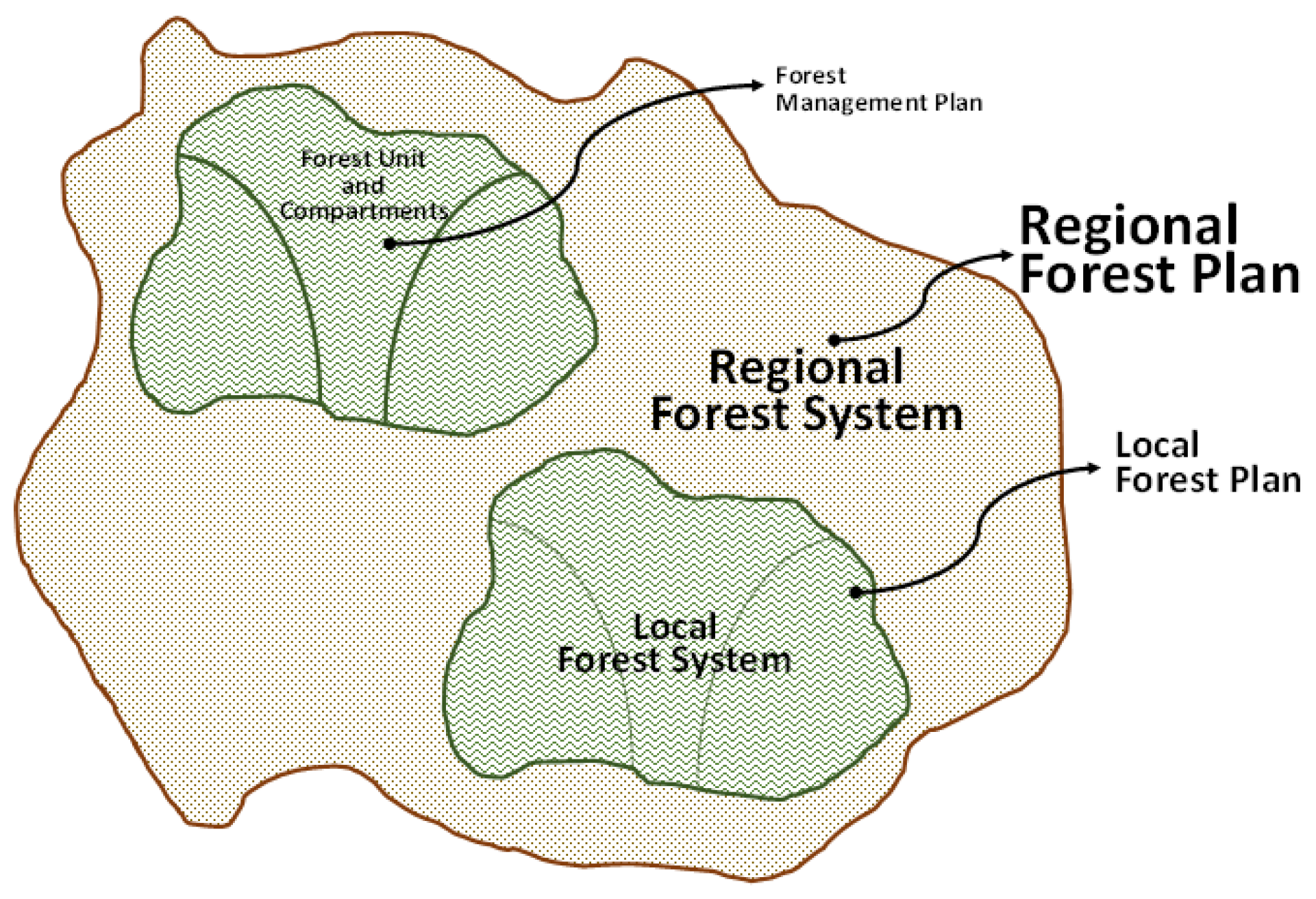
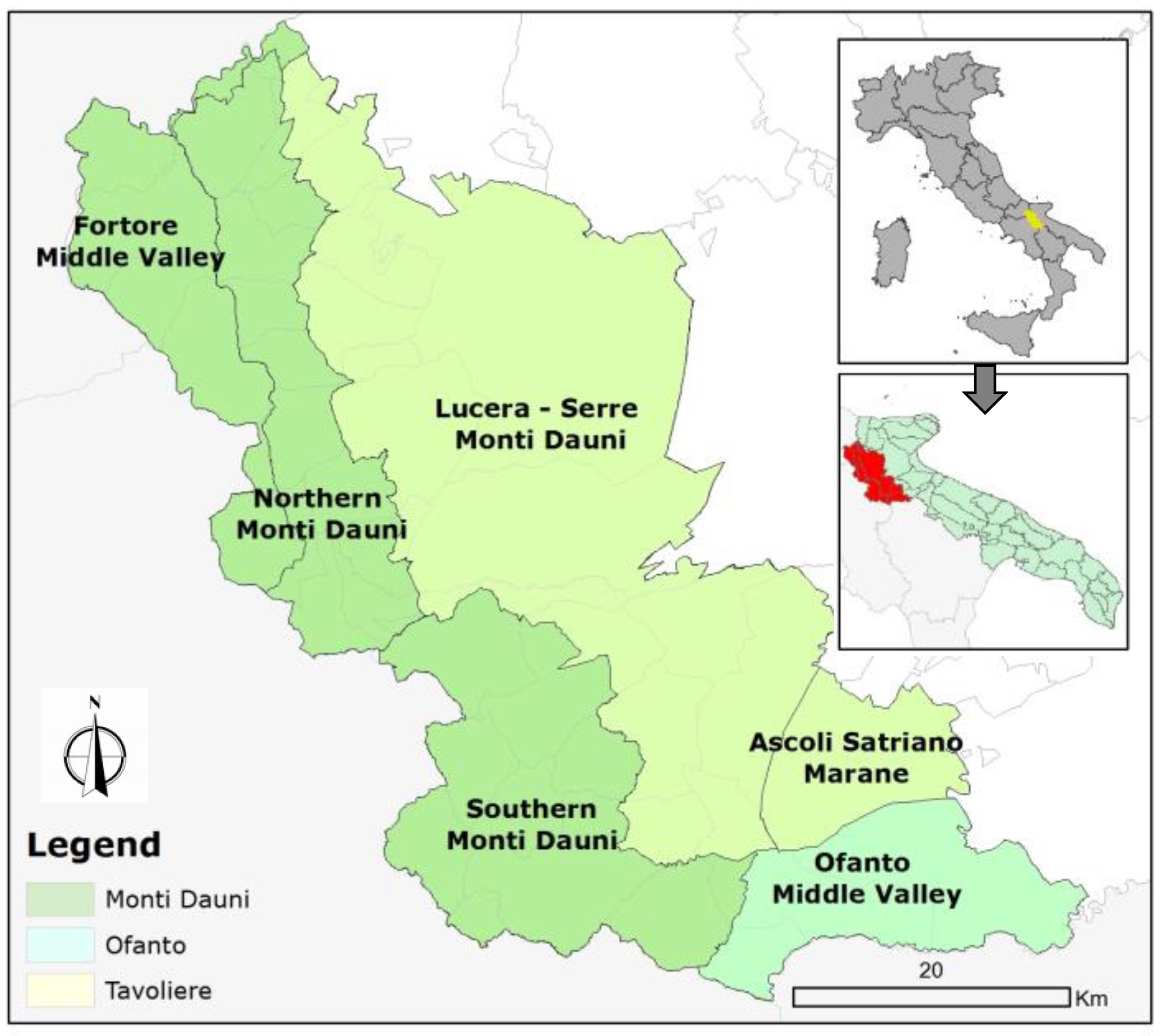
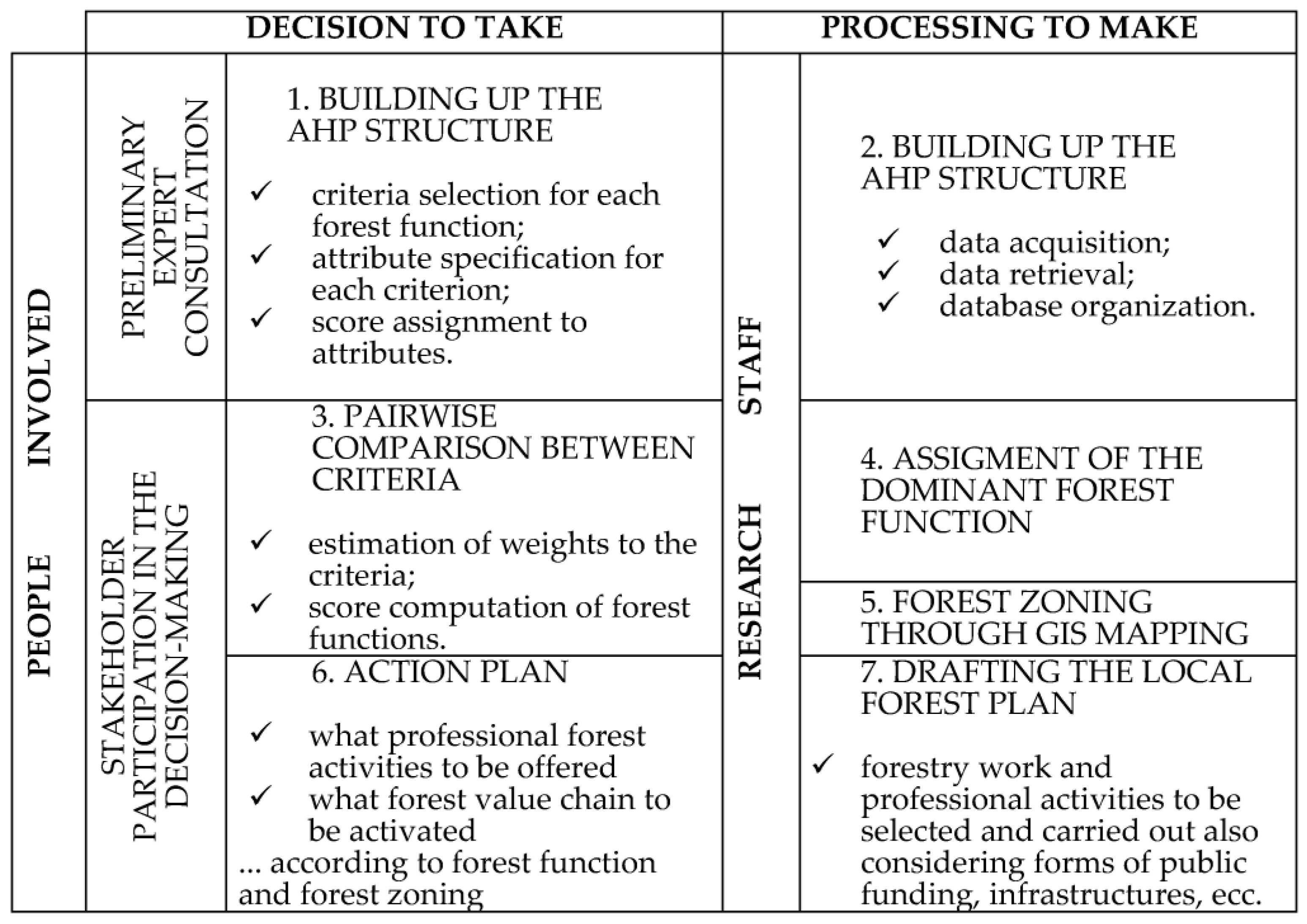
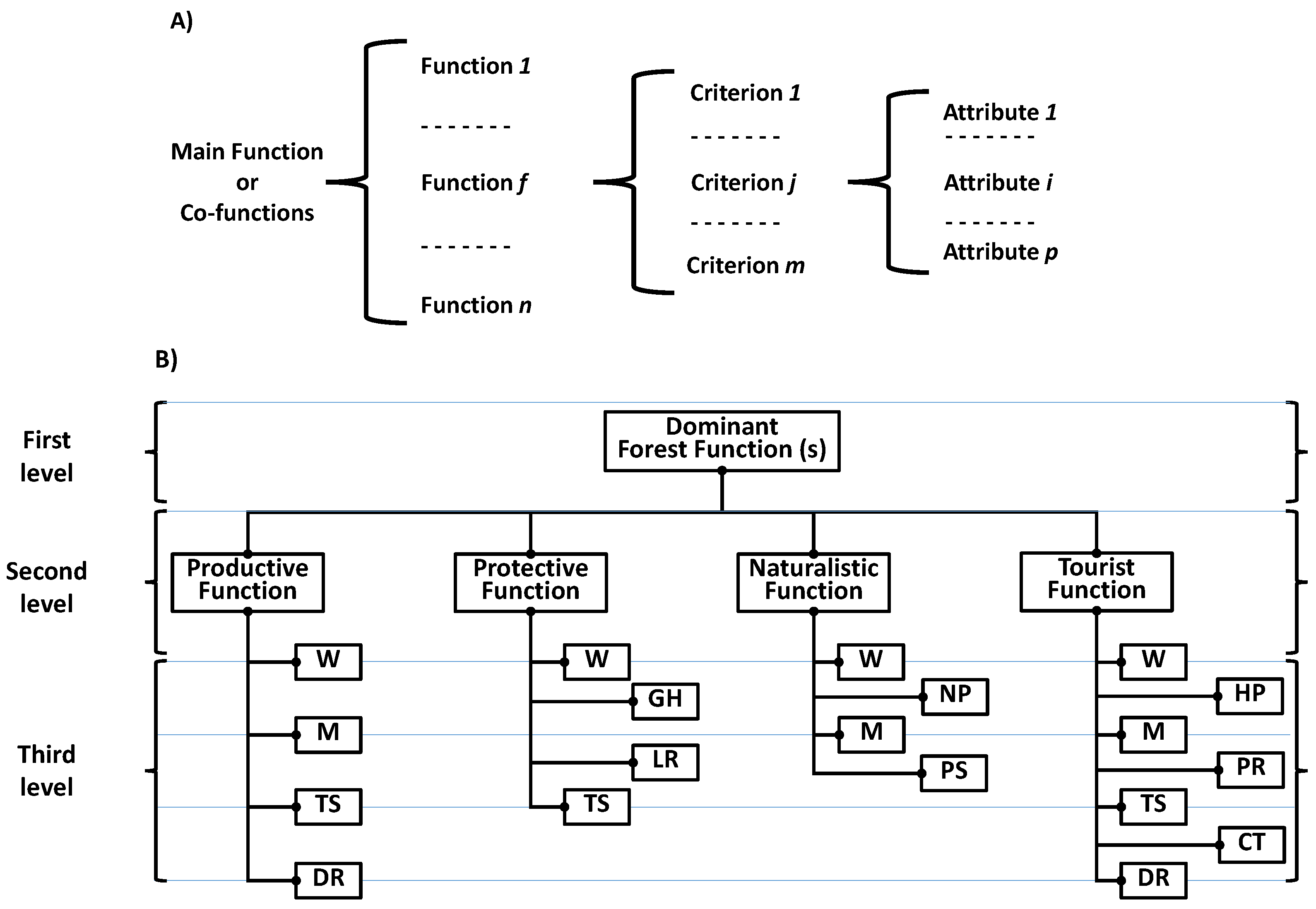
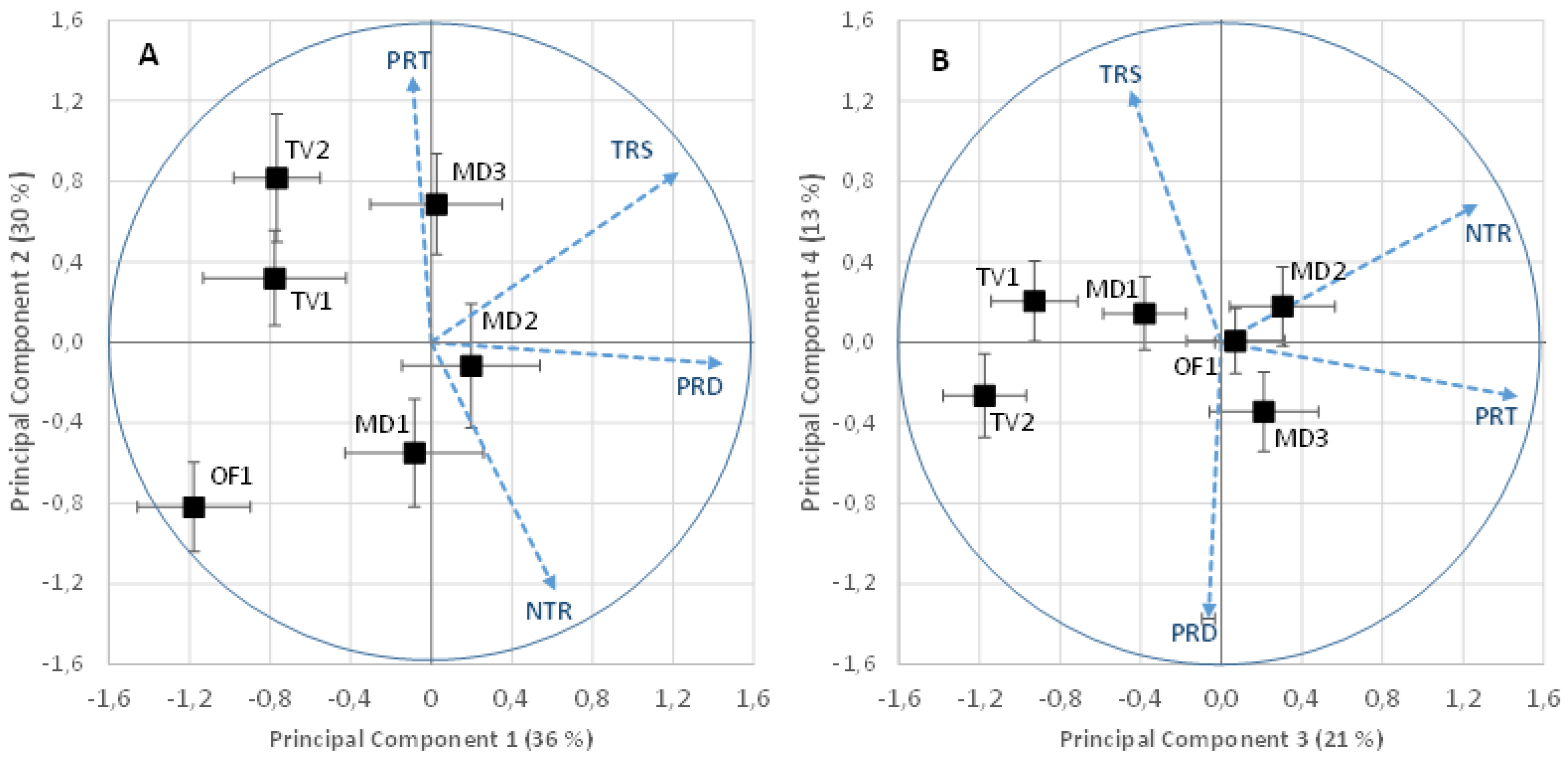
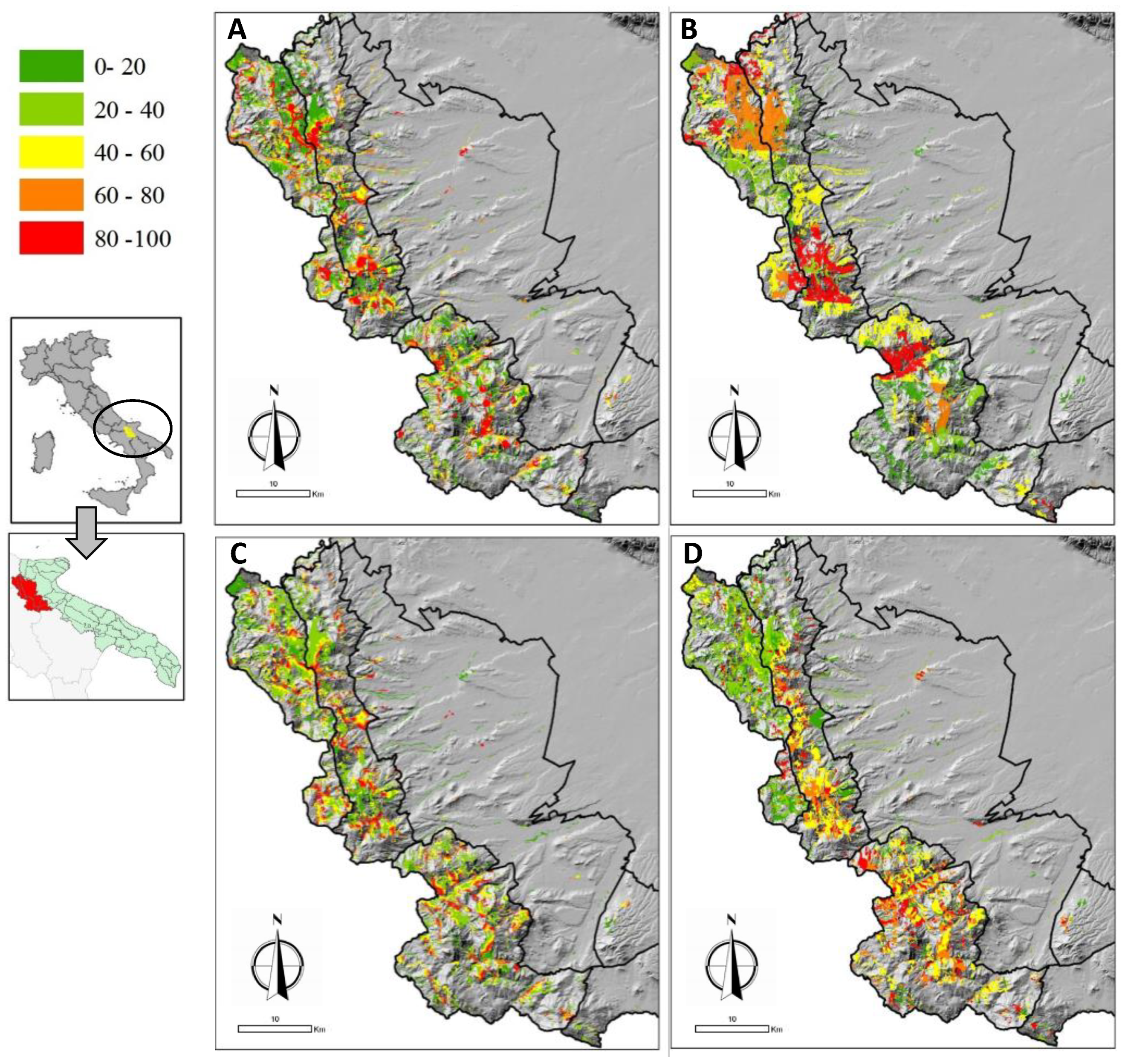

| W1 | W2 | W3 | W4 | W5 | Total | |
|---|---|---|---|---|---|---|
| M1 | - | 305.81 | 33.44 | 2.13 | 1214.27 | 1555.65 |
| M2 | - | 5043.01 | 43.29 | 3.31 | 13.73 | 5103.34 |
| M3 | - | 2.97 | 28.60 | 374.14 | - | 405.72 |
| MD1 | - | 5351.79 | 105.33 | 379.59 | 1228.00 | 7064.71 |
| M1 | - | 1384.27 | 172.78 | - | 838.31 | 2395.37 |
| M2 | - | 3808.37 | 39.29 | 0.38 | 1.98 | 3850.02 |
| M3 | - | 15.41 | 0.74 | 265.43 | - | 281.58 |
| MD2 | - | 5208.05 | 212.81 | 265.81 | 840.29 | 6526.97 |
| M1 | - | 374.61 | 9.74 | - | 562.30 | 946.65 |
| M2 | 18.39 | 5204.27 | 221.33 | 1.57 | - | 5445.55 |
| M3 | - | 6.98 | 160.62 | 222.83 | - | 390.44 |
| MD3 | 18.39 | 5585.87 | 391.69 | 224.40 | 562.30 | 6782.64 |
| M1 | - | 79.29 | 8.27 | - | 59.28 | 146.84 |
| M2 | - | 134.16 | 1.01 | - | - | 135.17 |
| M3 | - | 10.19 | 0.97 | 430.92 | - | 442.08 |
| TV1 | - | 223.65 | 10.25 | 430.92 | 59.28 | 724.10 |
| M1 | - | - | - | - | 57.78 | 57.78 |
| M2 | - | 77.16 | - | - | - | 77.16 |
| M3 | - | - | - | - | - | 0.00 |
| TV2 | 0.00 | 77.16 | 0.00 | 0.00 | 57.78 | 134.93 |
| M1 | - | 2.96 | - | - | - | 2.96 |
| M2 | - | 162.51 | - | - | - | 162.51 |
| M3 | - | 3.09 | - | 118.65 | - | 121.74 |
| OF1 | - | 168.56 | 0.00 | 118.65 | 0.00 | 287.21 |
| M1 | 0.00 | 2146.95 | 224.23 | 2.13 | 2731.94 | 5105.25 |
| M2 | 18.39 | 14,429.48 | 304.92 | 5.25 | 15.71 | 14,773.76 |
| M3 | 0.00 | 38.65 | 190.93 | 1411.97 | 0.00 | 1641.55 |
| Total | 18.39 | 16,615.08 | 720.09 | 1419.36 | 2747.65 | 21,520.57 |
| Forest Functions | Productive (PRD) | Protective (PRT) | Naturalistic (NTR) | Tourist (TRS) | |
|---|---|---|---|---|---|
| W | Weights → | 0.32 | 0.28 | 0.32 | 0.03 |
| W1 | evergreen oak forest | 5 | 5 | 4 | 5 |
| W2 | deciduous oak forest | 5 | 4 | 5 | 5 |
| W3 | other deciduous forest | 4 | 4 | 5 | 5 |
| W4 | riparian woods | 1 | 5 | 4 | 1 |
| W5 | reforestation with conifers | 1 | 5 | 1 | 3 |
| M | Weights → | 0.20 | 0.00 | 0.17 | 0.05 |
| M1 | old-grown forest | 4 | - | 4 | 5 |
| M2 | coppice | 5 | - | 3 | 3 |
| M3 | forest in natural evolution | 1 | - | 5 | 1 |
| TS | Weights → | 0.23 | 0.25 | 0.00 | 0.08 |
| S1 | >0–10 | 5 | 3 | - | 5 |
| S2 | >10–20 | 4 | 4 | - | 3 |
| S3 | >20 | 3 | 5 | - | 1 |
| DR | Weights → | 0.25 | 0.00 | 0.00 | 0.15 |
| DR1 | <100 | 5 | - | - | 5 |
| DR2 | 100–250 | 4 | - | - | 4 |
| DR3 | 250–500 | 3 | - | - | 3 |
| DR4 | 500–1000 | 2 | - | - | 2 |
| DR5 | >1000 | 1 | - | - | 1 |
| GH | Weights → | 0.00 | 0.23 | 0.00 | 0.00 |
| GH1 | low | - | 1 | - | - |
| GH2 | medium | - | 3 | - | - |
| GH3 | high | - | 5 | - | - |
| LR | Weights → | 0.00 | 0.24 | 0.00 | 0.00 |
| LR0 | not present | - | 0 | - | - |
| LR1 | present | - | 5 | - | - |
| NP | Weights → | 0.00 | 0.00 | 0.24 | 0.00 |
| NP0 | no protected area | - | - | 1 | - |
| NP1 | IPA area | - | - | 3 | - |
| NP2 | ZSC area | - | - | 5 | - |
| PS | Weights → | 0.00 | 0.00 | 0.27 | 0.00 |
| PS1 | 20–23 | - | - | 1 | - |
| PS2 | 24–26 | - | - | 2 | - |
| PS3 | 27–31 | - | - | 3 | - |
| PS4 | 32–36 | - | - | 4 | - |
| PS5 | 37–43 | - | - | 5 | - |
| HP | Weights → | 0.00 | 0.00 | 0.00 | 0.29 |
| HP0 | not present | - | - | - | 0 |
| HP1 | present | - | - | - | 5 |
| PR | Weights → | 0.00 | 0.00 | 0.00 | 0.12 |
| PR0 | not present | - | - | - | 0 |
| PR1 | present | - | - | - | 5 |
| CT | Weights → | 0.00 | 0.00 | 0.00 | 0.28 |
| CT0 | not present | - | - | - | 0 |
| CT1 | present | - | - | - | 5 |
| Sum of Weights | 1.00 | 1.00 | 1.00 | 1.00 |
| Forest Function | 5th Quint. | 4th Quint. | 3rd Quint. | 2nd Quint. | 1st Quint. | Total |
|---|---|---|---|---|---|---|
| NTR | 11.15 | 10.49 | 1.07 | 0.00 | 0.00 | 22.71 |
| PRT | 9.91 | 3.79 | 2.80 | 0.00 | 0.00 | 16.50 |
| PRD | 7.73 | 5.03 | 2.78 | 0.27 | 0.00 | 15.81 |
| TRS | 8.33 | 2.80 | 0.20 | 0.27 | 0.00 | 11.60 |
| PRD-NTR | 1.78 | 1.70 | 1.76 | 0.33 | 0.00 | 5.57 |
| PRD-TRS | 4.56 | 0.65 | 0.09 | 0.05 | 0.00 | 5.35 |
| PRT-TRS | 3.14 | 0.47 | 1.71 | 0.00 | 0.00 | 5.32 |
| PRT-PRD | 1.36 | 2.26 | 1.33 | 0.00 | 0.00 | 4.95 |
| PRT-NTR | 2.12 | 0.44 | 1.22 | 0.00 | 0.00 | 3.78 |
| TRS-NTR | 1.69 | 0.23 | 0.01 | 0.03 | 0.00 | 1.96 |
| PRD-TRS-NTR | 1.48 | 0.39 | 0.68 | 0.01 | 0.00 | 2.56 |
| PRT-PRD-NTR | 0.30 | 0.15 | 0.56 | 0.38 | 0.00 | 1.39 |
| PRT-PRD-TRS | 0.66 | 0.12 | 0.11 | 0.00 | 0.00 | 0.89 |
| PRT-TRS-NTR | 0.44 | 0.03 | 0.24 | 0.00 | 0.00 | 0.71 |
| PRT-PRD-TRS-NTR | 0.22 | 0.01 | 0.00 | 0.00 | 0.70 | 0.93 |
| Total | 54.86 | 28.56 | 14.55 | 1.33 | 0.70 | 100.00 |
| Forest Function | MD1 | MD2 | MD3 | TV1 | TV2 | OF1 | Total |
|---|---|---|---|---|---|---|---|
| NTR | 9.79 | 9.98 | 2.47 | 0.00 | 0.00 | 0.46 | 22.70 |
| PRT | 2.83 | 3.84 | 8.89 | 0.61 | 0.18 | 0.14 | 16.49 |
| PRD | 6.61 | 3.39 | 4.71 | 0.67 | 0.35 | 0.07 | 15.80 |
| TRS | 6.05 | 2.62 | 2.36 | 0.45 | 0.08 | 0.04 | 11.60 |
| Sub-Total | 25.28 | 19.83 | 18.43 | 1.73 | 0.61 | 0.71 | 66.59 |
| PRD-NTR | 3.02 | 1.46 | 1.01 | 0.04 | 0.00 | 0.04 | 5.57 |
| PRD-TRS | 1.61 | 1.94 | 1.61 | 0.18 | 0.00 | 0.01 | 5.35 |
| PRT-TRS | 1.37 | 1.66 | 1.90 | 0.38 | 0.01 | 0.00 | 5.32 |
| PRT-PRD | 0.11 | 1.26 | 3.56 | 0.01 | 0.01 | 0.00 | 4.95 |
| PRT-NTR | 0.18 | 0.88 | 2.03 | 0.29 | 0.00 | 0.40 | 3.78 |
| TRS-NTR | 0.58 | 1.13 | 0.25 | 0.00 | 0.00 | 0.00 | 1.96 |
| Sub-Total | 6.86 | 8.34 | 10.35 | 0.90 | 0.02 | 0.45 | 26.92 |
| PRD-TRS-NTR | 0.32 | 1.76 | 0.46 | 0.02 | 0.00 | 0.00 | 2.56 |
| PRT-PRD-NTR | 0.43 | 0.20 | 0.74 | 0.00 | 0.00 | 0.02 | 1.39 |
| PRT-PRD-TRS | 0.03 | 0.19 | 0.67 | 0.00 | 0.00 | 0.00 | 0.89 |
| PRT-TRS-NTR | 0.03 | 0.37 | 0.13 | 0.17 | 0.00 | 0.01 | 0.71 |
| Sub-Total | 0.81 | 2.52 | 2.03 | 0.18 | 0.00 | 0.03 | 5.57 |
| PRT-PRD-TRS-NTR | 0.25 | 0.25 | 0.36 | 0.06 | 0.01 | 0.00 | 0.93 |
| Gran-Total | 33.20 | 30.94 | 31.17 | 2.87 | 0.64 | 1.19 | 100.00 |
| MD1 | PRT | PRD | NTR | TRS | TV1 | PRT | PRD | NTR | TRS |
| PRT | −9.97 | PRT | 2.73 | ||||||
| PRD | −2.53 | −1.77 | PRD | −2.39 | 1.48 | ||||
| NTR | −8.44 | 5.45 | 11.35 | NTR | 1.04 | −2.40 | −17.99 | ||
| TRS | −0.99 | 0.94 | 0.71 | 7.27 | TRS | 8.05 | 2.47 | −1.03 | 4.85 |
| MD2 | PRT | PRD | NTR | TRS | TV2 | PRT | PRD | NTR | TRS |
| PRT | −6.06 | PRT | 10.02 | ||||||
| PRD | 1.21 | −10.78 | PRD | −2.07 | 33.67 | ||||
| NTR | −6.12 | 1.10 | 14.14 | NTR | −8.97 | −3.63 | −18.07 | ||
| TRS | 0.25 | 2.39 | 2.61 | −2.49 | TRS | −3.34 | −3.91 | −1.03 | 1.67 |
| MD3 | PRT | PRD | NTR | TRS | OF1 | PRT | PRD | NTR | TRS |
| PRT | 9.99 | PRT | −6.71 | ||||||
| PRD | 8.63 | −6.62 | PRD | −2.85 | −15.98 | ||||
| NTR | −2.52 | −0.40 | −10.13 | NTR | 25.00 | −0.11 | 20.69 | ||
| TRS | 0.96 | 1.25 | −0.22 | −3.37 | TRS | −4.93 | −3.14 | −1.03 | −7.93 |
| TRS | Ecotourism and Natural Life Activities and Socio-Cultural Services Related to the Forest | PRT | Social Services and Activities for the Public Benefit | PRD | Forestry Production Activities |
|---|---|---|---|---|---|
| TRS.1 | Hiking and Trekking: maintenance of trails; installation and maintenance of signage; forestry guide along the trails | PRT.1 | Emergency firefighting activities; preparation and maintenance of firebreak buffers and other fire protective arrangements | PRD.1 | Local sale of properly selected and assorted firewood |
| TRS.2 | Agritourist activity and forest hospitality | PRT.2 | Emergency intervention to provide assistance to injured, missing or endangered people in the forest | PRD.2 | Recovery of wood residues and activation of production processes to obtain wood chips, pellets, briquettes, etc. |
| TRS.3 | Outdoor sports and recreation (such as “adventure parks”); sensorial itineraries in the woods and in clearings | PRT.3 | Emergency intervention due to natural disasters in the forest: landslides, rock collapses, storms and floods, etc. | PRD.3 | Activation of the forest–wood–energy supply chain with “energy” as the final product; direct management of the “heat service” (through thermal biomass plants for district heating or energy communities) |
| TRS.4 | Management of equipped areas for camping (tents, caravans and campers) | PRT.4 | Management of vegetation on the side of the roads and along the margins through mowing operations and avoiding chemical weeding | PRD.4 | Start-up of small sawmills, carpenters and woodcraft workshops (production of barrels, parquet, bird nests, etc.) |
| TRS.5 | Management of a spectrum of activities related to forest parkour and a healthy lifestyle | NTR | Environmental and Ecosystem Services | PRD.5 | Production of wood boards alternative to hardwood, such as chipboard, laminated board, plywood and similar products |
| TRS.6 | Management of healthcare activities such as “forest therapy”, “forest bathing”, “forest immersion”, gentle gymnastics, yoga, relaxation and meditation practices, parkour life, sensory paths, etc. | NTR.1 | Afforestation and reforestation activities; agroforestry plants and ecological diversification systems at the landscape scale | PRD.6 | Non-wood products: mushrooms, truffles, berries, jujubes, nuts (chestnuts, hazelnuts, etc.), beekeeping and derived products (honey, propolis, royal jelly), medicinal plants. Laboratory for the preparation and conservation of the aforementioned products. |
| TRS.7 | Educational forest activities: kindergartens and schools in the woods | NTR.2 | Naturalistic engineering activities (slope consolidation, anti-erosion systems, runoff regulation, etc.) | PRD.7 | Assignment of pasture management; nomadic management of bee-hives |
| TRS.8 | Land art exhibitions in the forest or clearings close to the forest | NTR.3 | Design, management and maintenance of the land ecological network, also considering the ancient sheep tracks and other forms of green-ways | PRD.8 | Management of polycyclic, permanent and multi-purpose agroforestry plantations |
| TRS.9 | Equipped area for the observation of wild animals and birdwatching | NTR.4 | Reintegration/repopulation of wild animal species | PRD.9 | Small handicraft industry of forest resins and derived products (pitch, mastic, turpentine, Chios oil, white spirit, etc.) |
| TRS.10 | Botanical itineraries and orienteering courses and competitions | NTR.5 | Carbon capture and sequestration (both in the soil and in the wooden biomass) | PRD.10 | Biobased products obtained through “green chemistry” extraction processes |
| TRS.11 | Routes for mountain bikers, horse riding or excursions with pack donkeys. | NTR.6 | Agrienvironmental functions recognized by the CAP (Common Agricultural Policy) and subsidized through direct payments (eco-schemes, rural development measures, etc.) | PRD.11 | Forest nursery of autochthonous species with a high endemism value |
Disclaimer/Publisher’s Note: The statements, opinions and data contained in all publications are solely those of the individual author(s) and contributor(s) and not of MDPI and/or the editor(s). MDPI and/or the editor(s) disclaim responsibility for any injury to people or property resulting from any ideas, methods, instructions or products referred to in the content. |
© 2023 by the authors. Licensee MDPI, Basel, Switzerland. This article is an open access article distributed under the terms and conditions of the Creative Commons Attribution (CC BY) license (https://creativecommons.org/licenses/by/4.0/).
Share and Cite
Cammerino, A.R.B.; Ingaramo, M.; Piacquadio, L.; Monteleone, M. Assessing and Mapping Forest Functions through a GIS-Based, Multi-Criteria Approach as a Participative Planning Tool: An Application Analysis. Forests 2023, 14, 934. https://doi.org/10.3390/f14050934
Cammerino ARB, Ingaramo M, Piacquadio L, Monteleone M. Assessing and Mapping Forest Functions through a GIS-Based, Multi-Criteria Approach as a Participative Planning Tool: An Application Analysis. Forests. 2023; 14(5):934. https://doi.org/10.3390/f14050934
Chicago/Turabian StyleCammerino, Anna Rita Bernadette, Michela Ingaramo, Lorenzo Piacquadio, and Massimo Monteleone. 2023. "Assessing and Mapping Forest Functions through a GIS-Based, Multi-Criteria Approach as a Participative Planning Tool: An Application Analysis" Forests 14, no. 5: 934. https://doi.org/10.3390/f14050934
APA StyleCammerino, A. R. B., Ingaramo, M., Piacquadio, L., & Monteleone, M. (2023). Assessing and Mapping Forest Functions through a GIS-Based, Multi-Criteria Approach as a Participative Planning Tool: An Application Analysis. Forests, 14(5), 934. https://doi.org/10.3390/f14050934





